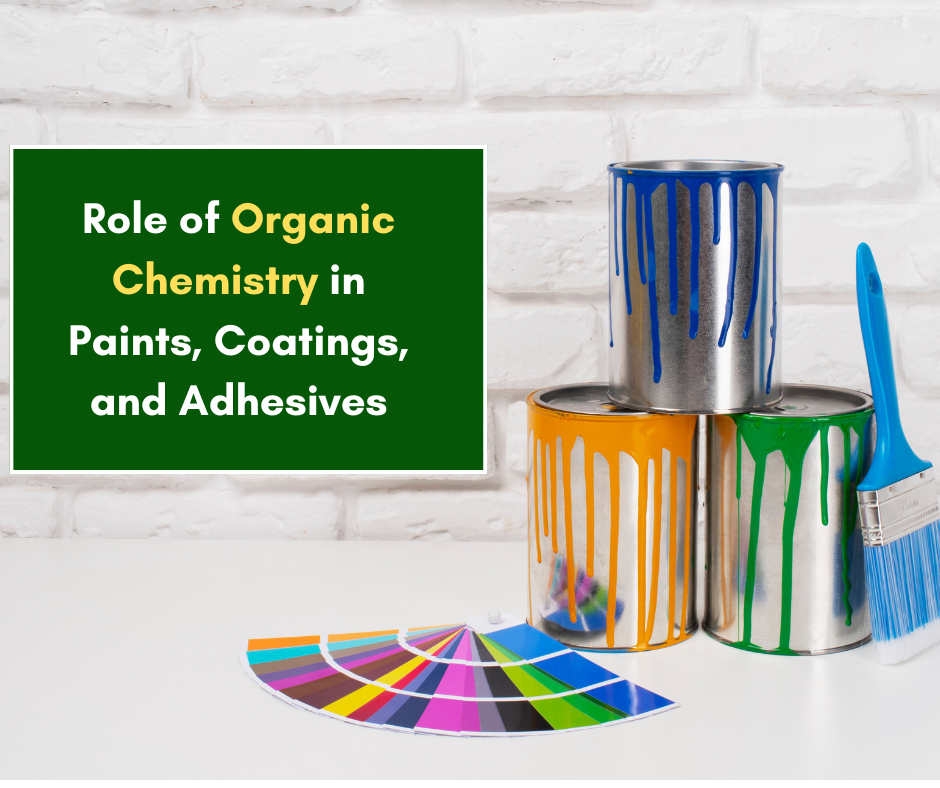Too Many Requests from Your Network
Please complete verification to access this content.
Role of Organic Chemistry in Paints, Coatings, and Adhesives
Organic chemistry plays a crucial role in the performance and development of paints, coatings and adhesives. These everyday materials owe their unique properties—from durability to flexibility—to the underlying principles of organic chemistry. Organic chemistry is the base of everything from the protective layer on a bridge to the colourful paint on your walls.
The Science Behind Paints
Paints are more than just decorative elements; they are complex chemical formulations designed to protect and enhance surfaces. Organic chemistry contributes significantly to their composition and functionality.
Binders:- The base and foundation of paint are binder materials can also be called polymers. They offer protection and longevity by creating a persistent layer that sticks to surface. Common organic binders may include alkyds, acrylics and polyurethanes.
Pigments:- pigments helps in determining the paint’s color and opacity. Many organic pigments are valued for their vibrant colours and chemical stability. Organic pigments showcase the versatility of organic chemistry as they are synthesized by utilizing aromatic compounds.
Solvents:- solvents made the paint easier to apply because it dissolve the pigments and binder. Although water-based solutions are becoming more and more popular due to their environmental friendliness, organic solvents such as toluene, acetone, and xylene are still often employed.
Additives:- Additives enhance and improve specific properties of paint, such as UV resistance, antimicrobial action and dying speed. Organic substances such like stabilizers and surfactants are crucial for the paints to function at their bet under various conditions.
Coating:- More than Just Visual Appeal
Coatings are engineered or designed for functionality rather than just visual finish. Organic chemistry plays a pivotal role in creating coatings with specialized properties, such as corrosion resistance, water repellency, and thermal insulation.
Protective Coatings: protective coatings are often utilize on metal structures such as bridges, pipelines rely on organic polymers such as epoxy resins. These polymers are synthesized via organic reactions that create a cross-linked structures, providing exceptional durability and chemical resistance.
Smart Coating: recent advancements made it possible to develop smart coatings, which react to changes in their surroundings. For example, self-healing coatings use organic microcapsules that release repair agents when a surface is damaged.
Eco-Friendly Coatings: organic chemistry also brings innovation in sustainable coatings. Low-VOC (Volatile Organic Compound) formulations and bio-based polymers are examples of how organic chemistry helps create environmentally friendly solutions.
The Role of Organic Chemistry in Adhesives
From construction to electronics adhesives are crucial. Their efficacy depends on the molecular interactions that are regulated by organic chemistry.
Types of adhesives may include:-
Epoxy Adhesives: These are two-part adhesives made from an epoxy resin and a hardener. Organic chemistry enables the cross-linking reaction between these components, resulting in strong, durable bonds.
Acrylic Adhesives: Known for their quick curing time and high strength, acrylic adhesives are synthesized using organic monomers like methyl methacrylate.
Hot-Melt Adhesives: These adhesives rely on organic polymers like ethylene-vinyl acetate (EVA) to provide flexibility and thermal stability.
Bio-Based Adhesives: for the sake environmental concerns, organic chemistry helps in making adhesives from renewable resources such as lignin and soy-based polymers. These alternatives and substitutes provide long-term solutions without compromising functionality.
Advancements and Future Trends
Organic chemistry continues to bring innovations in paints, coatings and adhesives. Key trends may include:
Green Chemistry: By focusing on sustainability, green organic chemistry is driving the development of bio-based materials, low-VOC formulations, and recyclable products.
Nanotechnology: Organic chemistry is integral to creating nanomaterials that improve the properties of paints, coatings, and adhesives, such as enhanced strength, UV resistance, and thermal conductivity.
Final Words
Organic chemistry is the base of paints, coatings and adhesives. From the vibrant pigments in paints to the durable polymers in adhesives, organic compounds enable these materials to meet diverse needs. Whether you’re painting a masterpiece, protecting a structure, or bonding materials together, organic chemistry plays a crucial role in it all.



